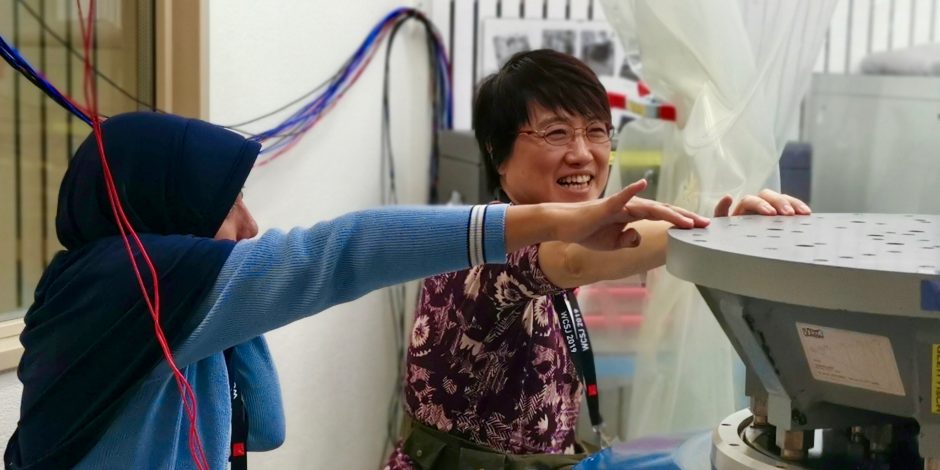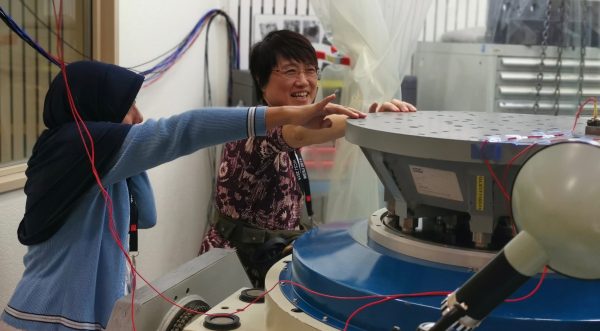Journalists from all over the world

During the first week of July 2019, science journalists from around the world gathered in Lausanne for a conference. On their last day, field trips took them to different places in Switzerland including the Geneva Observatory, Gornergrat and the University of Bern.

Journalists visiting the shaker lab at the University of Bern. (Photos Sylviane Blum)
“I never thought that a small institute like the one in Geneva would be so active in astronomy,” exclaimed French journalist Barbara Gineau Delyon, during a visit to the Observatory of the Unige’s Department of Astronomy. Indeed, if the astronomy department is known above all for the discovery of 51pegb, the first exoplanet orbiting a Sun-like star, few visitors are aware of the institute’s other activities, particularly those related to the manufacture of components for diverse instruments. For example, the NIRPS spectrograph (HARPS’ twin brother in infrared) which is being tested in the clean room, or the Fabry-Perrot series which will be used in other telescopes.
“An observatory without a dome, it is frustrating one,” exclaims Italian journalist Rossela Spiga, who didn’t notice that the dome was hidden in the forest next to the building. This frustration was quickly eliminated by the visit of the dome and its telescope, followed by the visit of Ecogia, the second site of the department specialized in high-energy astronomy. “You also have a satellite data reception centre,” says Marcus Strom as he leaves the small house that serves as reception for ESA Integral’s satellite, “and the place is also beautiful,” enthuses the Australian journalist after sitting in the shade of a plane tree for lunch. Once the meal was finished, the journalists boarded the bus to return to the Observatory where several specialists were waiting for them to describe in detail their areas of research.
Journalists were surprised by the extent of the fields studied by Geneva astronomers, and had the opportunity to get an idea of the super novae, distant galaxies, bigbang, stellar chemistry and also the instruments used. “I thought the Americans had the best telescopes and instruments,” explains surprised Iorno Niccolo, scientific advisor at the Department of Foreign Affairs, “but I see that Europeans, especially with La Silla, the VLT, the future ELT and institutes like the one in Geneva, are just as well equipped if not better”.
Impressive panorama at Gornergrat
On Friday, July 5th a group of 11 journalists visited the Gornergrat. Thomas Marbach, the manager of the Kulmhotel 3100, and Dr. Timm Riesen, the director of the observatory, greeted them and bade them welcome to the second highest hotel in Europe and one of the most scenic points inside Switzerland. The group was taken (slowly) upstairs through the hotel’s upper floors where sign posts lead the way to the 23 guest rooms, each named after one of the famous over 4000m high mountains defining the impressive panorama around the Gornergrat.
In the Stellarium’s control room, the journalists learned about the history of the Kulmhotel, the famous cogwheel train, the high alpine research station, and its current use as a major outreach facility. Up in the cupola, Riesen explained the different instruments and installations and later opened the dome to the sky, showing off the beautiful scenery. With thanks to the weather gods, the sight of blue skies, golden light, snow covered peaks and beautiful glaciers enchanted the audience much to their delight. The tour was rounded off with a Q & A session on the marvellous outside “cat walk” around the dome, where the impressive panorama can be appreciated without obstructions. Many enthusiastic “Ah and Oh”s were heard and, according to their statements, the journalists were genuinely impressed and will not forget that visit anytime soon.
Amazing shaker in Bern
Another group of science journalists travelled from Lausanne to Bern. “The visit arranged for us at the University of Bern had several “wow” moments through the afternoon, especially holding part of the solar wind experiment that went to the Moon with Apollo 11, and seeing the test version of CHEOPS,” summarizes Cassandra Cavallaro, Online Community and Content Officer of the SKA Organisation in UK: “A big thank you to Prof. Willy Benz, Prof. Nicolas Thomas and Thierry De Roche for their time and their entertaining presentations, and to all involved in preparing the visit. I can honestly say it was the highlight of the week. Since returning home I have told many people about the trip and the university’s long history of contributing to space missions, and I wish the team in Bern all the best with CHEOPS and BepiColombo!”
First, the journalists had followed Einstein’s footsteps visiting his apartment near the famous clocktower “Zytglogge” and the Einstein exhibition in the “Bernisches Historisches Museum” before they came to the University of Bern. “Frankly speaking, my main purpose of the Bern visit was Einstein. But the Einstein Museum was within the range of assumption, so to say. On the other hand, the visit of the University of Bern was beyond my assumption,” says Mariko Takahashi, senior staff writer of the Japanese “The Asahi Shimbun”, the world’s second-largest newspaper: “I was surprised by the fact that the university had played an important and fundamental role in the production of spacecrafts. This experience changed my image of the university.” As her Indonesian colleague she was particularly impressed by the demonstration of the shaker that simulates a rocket launch. “What I liked the most is when we touched a trembling giant metal disk which simulated the situation when a rocket or space probe is launched. Amazing!” remembers freelance journalist Dyna Rochmyaningsih.
Categories: Internal Newsletter, Uncategorized

